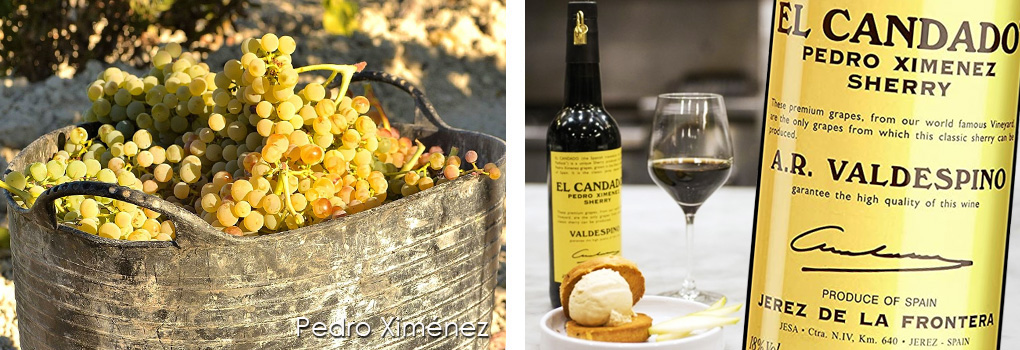Sherry:
Sherry is a fortified wine originally produced in and around the town of Jerez, Spain; in Spanish it is called 'Vino de Jerez'. The town's Persian name during the Rustamid period was Xerex (Shariz, in Persian), from which Sherry and Jerez are derived.
Spanish producers have registered the names Jerez - Xérès - Sherry and will prosecute producers of similar wines from other places using the name. By law, Sherry must come from the famous 'triangle' area in the province of Cadiz between Jerez, Sanlúcar de Barrameda, and El Puerto de Santa Maria.
Sherry is made in Spain from three traditional white grapes: Palomino, Pedro Ximénez and Moscatel. Fortified 'Sherry-style' wines made in other countries often use different grape varietals.
Sherry differs from other wines because of how it is treated after fermentation. Fortification takes place after fermentation, all natural Sherries are fermented dry; any sweetness is applied later. In contrast, Port wines are fortified halfway, stopping fermentation so not all of the natural sugars turn into alcohol, leaving a sweet wine. Sherry is first fortified with grape spirit to around 15% Alc./vol. and then if destined to be a Fino style, a yeast called 'flor' is allowed to grow on the surface of the wine to protect it from exposure to oxygen. The for example an Oloroso style is fortified to a strength of around 17% where the 'flor' cannot grow so thick, so more exposure to oxygen occurs during the ageing process in (traditional 600 litre Butts) oak barrels.
Styles of Sherry: - *(serve slightly chilled 8° - 13°C)
• Fino ('fine') - a pale and the driest of the traditional styles of Sherry.
• Manzanilla - a very pale style of Fino Sherry made around the port of Sanlúcar de Barrameda.
• Amontillado - aged first under a cap, vale of 'flor' then slowly exposed to oxygen, which produces a style darker than Fino but lighter than Oloroso.
• Oloroso ('scented') - aged oxidatively for a longer time than Fino or Amontillado Sherries, producing a darker & richer style of Sherry wine.
• Palo Cortado - a very rare style, fortified and aged without 'flor', it develops the richness of Oloroso and retains the crispness of an Amontillado.
Blended / Sweetened Sherry Styles:
*There are different labels for sweetened Sherry, based on their sugar content and flavour profile.
• Pale Cream - contains between 45 - 115 grams of sugar per litre. The base is made from Fino or Manzanilla – so it retains a bright colour & grape must is added as a sweetener.
• Medium - contains between 5 - 115 g/L. The base wine is typically Amontillado.
• Cream - contains between 115 - 140 g/L. The base wine is usually Oloroso, sometimes Amontillado & blended with some Pedro Ximénez or Moscatel to sweeten.
• Pedro Ximénez & Moscatel - extremely rich sweet style wines that form the preferred base for sweetening the base of dry sherries. They are rarely bottled on their own, though when they are - Pedro Ximénez makes one of the world's best dessert style wines, having sugar levels between 200 - 400g/L - enjoy the journey.
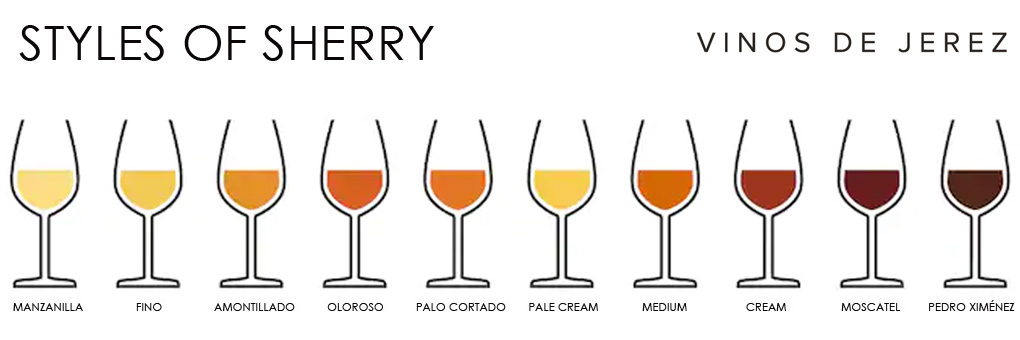
Solera System:
The Solera System (or process) is the aging of wine, brandy and even vinegar - by blending small fractions of the contents from different aged barrels in such a way that the finished product is a mixture of ages - with the average age gradually increasing as the process continues over many years. A solera is literally the sequential-set of oak barrels used in the process. Products which are often solera aged include; Sherry, Madeira, Marsala, Mavrodafni, Muscat, Balsamic, Commandaria, Sherry Vinegar, Spanish Brandy and Spanish Rums.
This process known as solera (a Spanish word for floor, referring to the bottom row), was developed by the producers of Sherry. In a Spanish Sherry Solera, the vintner may transfer up to a third of each barrel, each year. A Solero Sherry has to be at least 3 years old when bottled.
The traditional Sherry Solera was exposed to the sun, hence the name. The warmth of the sun encourages an active fermentation process, aging and development. This unique blending system consists of several rows (known as criadera's) of small oak barrels stacked upon one another grouped by vintages. The oldest is at the bottom and the most recent, youngest wine at the top.
At bottling, approximately one third of the contents of each of the barrels on the bottom level is removed. Sherry from the row immediately above will replace what was removed and so on until a complete transfer is made from top to bottom.
No wine-barrel is ever completely drained, so some of the earlier product / wine always remains in each oak barrel. This wine remnant diminishes to a tiny level, but there can be significant traces of this wine much older than the average, depending on the transferred fraction. In theory traces of the very first wine placed in the 'solera system' may be present even after 50 or 100 years.
On the ancient island of Sicily, where Marsala wine is made, the system is called 'in perpetuum' - (from Latin - forever).
Some Sherry and especially Madeira can be labelled with the word 'Solera' and a date. This is a marketing strategy, as it simply means the year that the Solera was started, and the bottle may contain trace amounts from that year, potentially.
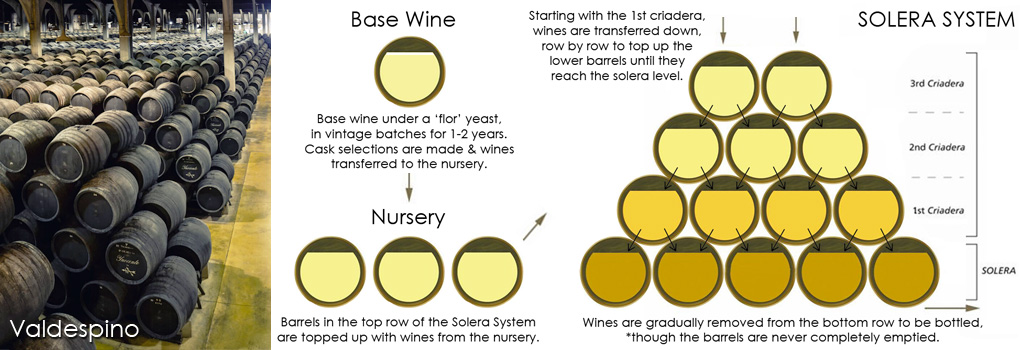
Flor:
Flor - Spanish and Portuguese for 'flower' is a winemaking term referring to a film of yeast on the surface of wine and which is important in the manufacture of Sherry.
The flor is formed naturally under certain winemaking conditions, from indigenous yeasts found in the region of Andalucia in southern Spain. Normally in traditional winemaking it is essential to keep wines away from exposure to air, to avoid infection by bacteria and unknown yeasts that can possibly spoil the wine.
However, in the manufacture of Sherry, the slightly porous oak barrels are deliberately filled only five-sixths full with wine, leaving an empty gap - space of two fists, so as to allow the flor yeast to take form and the barrel bung is not completely sealed.
The flor prefers cooler conditions and higher humidity. So the Sherries produced in the coastal Sanlucar de Barrameda and El Puerto de Santa Maria have a thicker cap of flor than those produced inland in Jerez. Depending on the development of the wine, it may be aged entirely under the flor to produce a Fino or Manzanilla Sherry, or it may be fortified to limit the growth of flor and undergo oxidative aging to produce an Amontillado or Oloroso Sherry.
During fermentation of Sherry production the flor - the physiology of the yeast change, as a result of their higher fat content compared with other yeasts, they float - a property which is especially important if they are to contribute to a healthy surface film. Flor survives between a narrow alcohol range of 14.5% to 16%. Below 14.5% Alc./vol, and the yeast does not form a protective waxy cap and the wine oxidizes to the point of becoming vinegar. Above 16% and the flor cannot survive, the wine essentially becoming an Oloroso Sherry.
These unique yeasts are responsible for the production of the green almond, granny smith and nougat characters that characterise great Fino Sherry. The chemistry of flor goes far beyond this, but to say, the flor film is primarily responsible for most of the complex characters found in these wines. The different styles of Sherry would not be remotely the same if they lacked its unique influence on their character.

Palomino Grape:
Palomino is a white wine grape varietal - historically linked with and widely planted in Spain (particularly in the Jerez region). Best known for its key role in the production of Sherry. Palomino has 3 sub-varietals: Palomino Fino, Palomino Basto, and Palomino de Jerez - with Palomino Fino by far the most important grape varietal for quality Sherry wines.
The resulting wine is low in both acidity and sugar which, making it ideal for Sherry, but it also means that table wines made can be low quality, unless fruit acid is added.
In France it is known as Listan, and in South Africa it is called Fransdruif meaning White French. The grape is also planted in Australia and New Zealand where it is typically used to produce 'fortified' wine styles.
The wine 'must' has a tendency to oxidize quickly, a characteristic that can be ignored when used for Sherry production. Approximately 95% of the grapes grown for Sherry are Palomino. As a varietal table wine, the Palomino grape generally produces a wine with very bland palate characteristics.
The Albariza soil is the best for growing the Palomino grape, and by law 40% of the grapes making up Sherry must come from Albariza soil. The Barros and Arenas soil are mostly used for Pedro Ximénez and Moscatel grapes - both used exclusively for sweet Sherry.
Palomino originated in the Andalusia region of southern Spain - and was supposedly named after one of King Alfonso X's knights. It is high yielding, producing about 80 hl/ha without irrigation and can reach as much as 150 hl/ha. Harvested in early September, the 'must' from the first pressing, the 'primera yema', is used to produce Fino and Manzanilla and the 'must' from the second pressing, the 'segunda yema' used for Oloroso; any additional pressings is used for lesser wines, distillation and vinegar.
The 'must' is then fermented in stainless steel tanks until the end of November, producing a dry white wine with 11-12% alcohol. The Palomino grape covers approximately 28,000 hectares throughout Spain. At one point in time, Palomino Fino was one of 100 different grape varietals used in Sherry wine production.
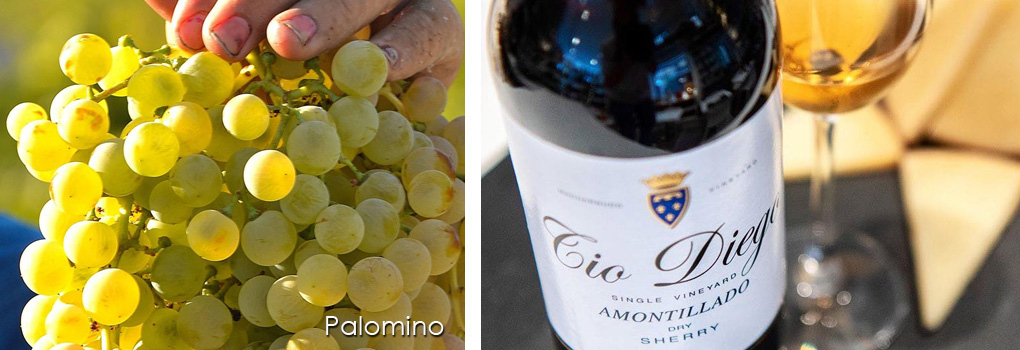
Amontillado:
Amontillado is a particular dry style of Sherry, characterised by being darker in colour than a Fino, but lighter than an Oloroso Sherry. It is named for the 'Montilla' region of southern Spain, where the style originated in the 18th century, although the name 'Amontillado' is sometimes used commercially as a simple measure of colour to label any Sherry lying between a Fino and an Oloroso style.
An Amontillado Sherry begins life as a Fino, fortified to approximately 13.5% alcohol with a cap of 'flor' yeast limiting its exposure to oxygen. A cask of Fino is considered to be Amontillado if the layer of flor fails to develop effectively, or is intentionally killed-off by additional fortification, or it is allowed to die off through non-replenishment.
Without the layer of flor, Amontillado must be fortified to approximately 17.5% alcohol so that it does not oxidise too quickly. After the additional fortification, Amontillado oxidises more slowly, exposed to oxygen through the slightly porous American oak casks. It achieves a darker colour and richer flavour than a Fino - naturally a dry style Sherry; they are sometimes made light to medium sweet.
An Amontillado Sherry can be produced in several different manners. A ‘Fino-Amontillado’ is a wine that has begun the transformation from a Fino to an Amontillado, but has not been aged long enough to complete the process; the result a ‘medium sherry’ is an Amontillado that has been slightly sweetened. Then there is an ‘Amontillado del Puerto’ Sherry, which is an Amontillado specifically made in El Puerto de Santa María.
Due to its oxidative aging and preparation, Amontillado is more stable than Fino and may be stored for a few years before opening. After opening, it can be kept for up to two-three weeks, if re-corked and stored in the fridge.
Amontillado Sherry is usually best served slightly chilled, and may be served either as an apéritif, or as an accompaniment to food such as chicken, veal, pork or rabbit with mushrooms. Classically it was served with a fine, or thin, soup, like a beef consommé.
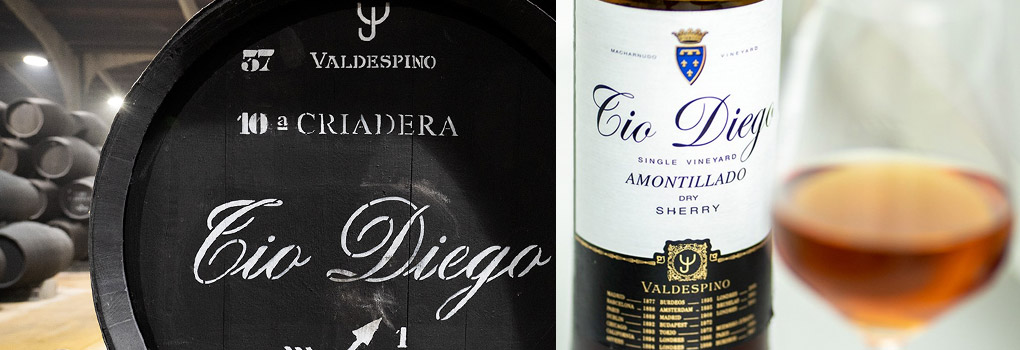
Pedro Ximénez:
Pedro Ximénez (also known as P.X.) is a white wine grape varietal grown in selected wine regions of Spain. Both a blending component and in its own right a varietal wine, which is an intensely sweet, dark, dessert style Sherry wine.
P.X. was originally grown in the Montilla-Moriles DO region of southern Spain, and along with Palomino Fino made up the majority of grapes used in the production of Sherry. However, the strong resistance of the Palomino grape to disease has led to a great decline in the use of Pedro Ximénez in traditional Sherry, and despite its continued use in the sweeter blends of Sherry in Montilla-Moriles, Malaga and other regions of Andalusia, its fame now rests principally on its use in the varietal raisin, straw-wine of the same name.
The dessert wine Pedro Ximénez is made by partly drying the grapes in a time-honoured fashion under the hot Spanish sun for two or three weeks on straw-mats, in order to allow the concentration of the natural sugars and sweetness. The amount of residual sugar in Pedro Ximénez wines is at least 210 grams per litre, but they will typically rest between 300 and 500 grams of sugar per litre.
The 'must' of these raisin grapes ferments very slowly - creating a wine of extraordinary depth and complexity of flavour, which are then used to create a thick, dark liquid with a strong taste of raisins, figs, dates, molasses and mocha-coffee that is fortified and is used as a blender to sweeten Oloroso Sherry and aged in solera.
Pedro Ximénez can be quite crisp and dry when vinified still - but is more frequently used as a sweetening agent in Sherry, with the concentrated juice from the partly dried grapes, with intense flavours. In Spain the dried P.X. grapes are vinified and then aged, matured using the 'Solera and Criadera' system in oak barrels for many years and produce fortified wines of considerable character and sweetness.
Best enjoyed when served chilled at 9-12ºC and paired with desserts; chocolate torte, churros (Spanish donuts with chocolate sauce), pastries and is truly delicious poured over walnut ice-cream. As an after dinner drink, it is a great way to finish the perfect meal - enjoy the journey.
